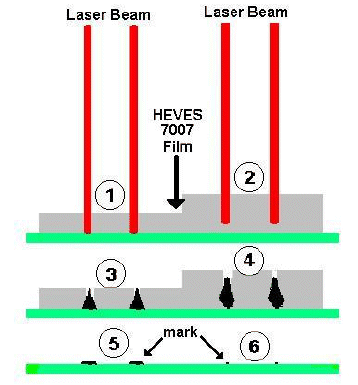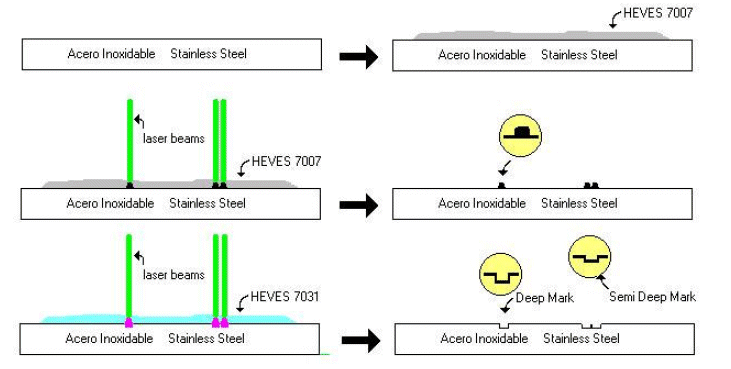Directions for Laser Engraving or Marking with Heves Chemical Formulations (Inks)
Application: Spray brush, roller, aerograph or air spray
1. Prepare the surface, SHAKE the bottle with the suitable product and load the already humid brush, by plunging it until the half of the hairs
2. Apply smoothly on the surface in a single passing and with the brush almost horizontal to the surface, never vertical)
3. The film must be uniform, continuous and thin, which is achieved easily with brush and little practice or even using aerograph or air spray (previous dilution of the product with water)
4. Let dry and apply the laser at the established power and time. It is always convenient to test these variables in a sample of the material, before the real work.
5. After marking remove the surplus by washing with water and by cleaning out with a wet sponge or cloth.

A thin film (1) produces better results (3) with maximum performance (5) A film too thick (2) would give low quality results, because the laser won´t effectively heat the metallic surface, (4) and the necessary temperature will not be achieved on the surface. This results in low-sticking films with brownish color. (6) The product yield (g per square cm) will be lower. To prevent this, decrease the viscosity of the product adding a few water drops.
Different chemicals for laser engraving on different conditions
The HEVES 7007, HEVES 7011 and HEVES 7042 products produce marks over the treated surface.
The Heves 7031, HEVES 7040, HEVES 8010 products produce marks into the treated surface.

General conditions for Laser Irradiation
Power and Times
The laser engraving works by instantaneous and punctual temperature elevation in the surface of the substrate material.
This temperature created on the application surface, fundamentally depends on:
A) The applied power
B) The time that the laser remains on a given point (speed)
C) The quantity of laser impacts per area unit (DPI and PPI)
The temperature in the application point is: potency x time , that is to say the temperature increases with power and decreases with speed.
The HEVES products are formulated for 25 to 50 watts Laser power and to medium speeds, but can work very well with more or less power Laser Machines. Always test your conditions at different potencies and speeds on a disposable sample of the material.
The surface must be perfectly covered with thin film and be perfectly dry.
Check the contact temperature by looking at the light color emitted by the surface .
In all cases to engrave in METALS, it is necessary to achieve a bluish white to reddish white color.
To engrave in Ceramics, it is necessary to achieve a reddish white to clear red color.
To engrave in GLASS, it is necessary to achieve Clear reddish to Dark red color.
To engrave in Plastics it is necessary to achieve Dark reddish to colorless.
Procedure to search the Best Engraving Condition:
First: Know the nominal power of the laser Machine
Second: know the ALFA condition, that is to say the conditions that uses the operator to give the necessary energy to achieve a good black color on stainless steel (without using additives, in the YAG laser, or using any additive in CO2 Láser machine)
Example: In a 30 watts power, CO2 laser machine, using HEVES 7007, the condition of start-up is something as (100 %) of the maximum power and between the 8 to 10% of the maximum speed.
How to choose the best chemical formulation among the Heves product – The relation between Metals, Ceramics, Glasses and Plastic is:
A) Check decreasing the power and/or increasing the speed
For Metal (using HEVES 7007, HEVES 7011 or HEVES 7031) and considering the delivered energy (power, speed and pulse frequency) as 100 %, then:
For Ceramic (different according to the type) the energy to be used is near 20% of required for Metal (above)
For Glasses and Crystals (different according to the type) the energy to be used is near 15%
For Plastic (different according to the type) the energy to be used is 8 to 15%
After finding some visible effect on the material that we are treating, it is necessary to increase or decrease the energy according to the results:
In general on Steel with CO2 laser, more energy gets more color and adherence on the metal.
For Aluminum it is necessary to be cautious and NOT to surpass the correct temperature, because it will decrease the marking and adhesion and thus the color, for Aluminum fusion or volatilization.
On Ceramic and Glasses, an energy excess prevents the color expression because micro breaks and loss of material, resulting in the laser “eating “ the surface
On plastics it is only necessary to melt the plastic to obtain adhesion, without reaching burning point.
Using laser machines superior to 50 watts potency
HEVES 7007, HEVES 7011 and HEVES 7031, works whell with medium or low powers and/or high speeds
If you don´t get the expected results, it can be for excess of temperature on the substratum (very common situation in the case of engraving on Aluminum, where it is necessary to try the better point, not to exceed nor neither stay short of the appropriate temperature)
B) Apply the laser on the product when the ink is still humid (not wet)
HEVES 7007, HEVES 7011 and HEVES 7031 Performance (yield):
A 50 g bottle as minimum should be enough for 6.000 square cm. It can be dilluted with a few drops of water for a further increase of yield.
In the pieces of 3 x 2 cm (6 cm2) that is 1000 pieces approximately, depending on the operator`s skill and the quality of the brush. It must be soft, with fine hairs and maximum wide compatible with the surface to be painted.
A too thick film is doubly harmful, because decreases seriously the performance of the product and also affects the adhesion and coloring.
The correct use of aerograph or air Spray generaly implies the product dilution with water, to achieve the appropriate painting viscosity, in this case the performance increases up to 25 %.
Use Precautions
Do not change the plastic bottles caps or use two products with the same brush. Contaminations between productsinvariably affects stability shelf-life.
Cleaning the surface
If the surface to paint is dirty or oily, either petroleum or silicone oils (somewhat very common in well polished steels, in knifes for example), a “cut” effect or incomplete wetting can appear when the product is applied.
This “cut” effect or wrong wetting is related with the surface tension and depends very much on the previous treatment of the material.
Clean and polish method
The improvement of contact can be made for several ways, one of them is to make use of the cleaning properties included in the HEVES products and rub a little with the brush, in order to clean out while applying the product
Drying Speed
For drying, there are several options:
A) With the HEVES creams, you can use a thinner layer of product. You can also try diluting in another recipient, by mixing the product and some drops of common water.
B) In all cases get very quick drying can be accomplished by means of hot air with a common hair dryer.
C) In some materials according to the thickness of the placed film or the high power of used laser, the substrate can be engraved without waiting for a complete drying of the film (try it before using the definitive material)
Ask about our line of Laser Engraving Supplies: chemicals, special formulations, inks.

